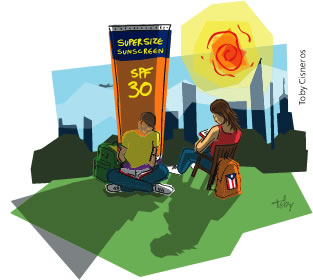|
 The message to use sunscreen and be aware of the risks of skin cancer does not seem to be getting through to white Hispanic teenagers in Miami-Dade County. That’s the conclusion of a study done by researchers at the Miller School’s Departments of Dermatology and Cutaneous Surgery and Epidemiology and Public Health along with the Sylvester Comprehensive Cancer Center. The survey of 369 students at Killian High School found that white Hispanic teens were more likely to use tanning beds and less likely to consider themselves at risk for skin cancer or protect themselves from the sun than white non-Hispanic teens. The message to use sunscreen and be aware of the risks of skin cancer does not seem to be getting through to white Hispanic teenagers in Miami-Dade County. That’s the conclusion of a study done by researchers at the Miller School’s Departments of Dermatology and Cutaneous Surgery and Epidemiology and Public Health along with the Sylvester Comprehensive Cancer Center. The survey of 369 students at Killian High School found that white Hispanic teens were more likely to use tanning beds and less likely to consider themselves at risk for skin cancer or protect themselves from the sun than white non-Hispanic teens.
Overall, white Hispanics have a lower rate of skin cancer than white non-Hispanics but are more likely to be diagnosed at a later stage. That led the authors of the study to “hypothesize that these differences may exist in students and may be related to early acquisition of knowledge.” The findings were published in the August issue of Archives of Dermatology, one of the JAMA/Archives journals.
In the survey, students (221 white Hispanics and 148 white non-Hispanics) were asked about their skin cancer knowledge, perceived risk, and sun protection behaviors. White Hispanic students were 60 percent less likely to have heard of skin self-examination and 70 percent less likely to have been told how to perform it when compared to white non-Hispanics. The Hispanic students were more likely to tan deeply but twice as likely to never or rarely use sunscreen.
“Even after controlling for skin cancer risk factors, white Hispanic students had differences in knowledge and behavior related to skin cancer protection,” says Robert S. Kirsner, M.D., Ph.D., Stiefel Laboratories Professor and vice chairman of the Department of Dermatology and Cutaneous Surgery, member of the Biobehavioral Oncology and Cancer Epidemiology Program at UM/Sylvester, and the study’s senior author. “This suggests delayed diagnosis, and the rise of skin cancer in Hispanics may be due to lack of knowledge.” Kirsner, who published a 2006 study that found melanoma is diagnosed later among blacks and Hispanics compared to white patients, says this new research “provides opportunities for intervention.” |


